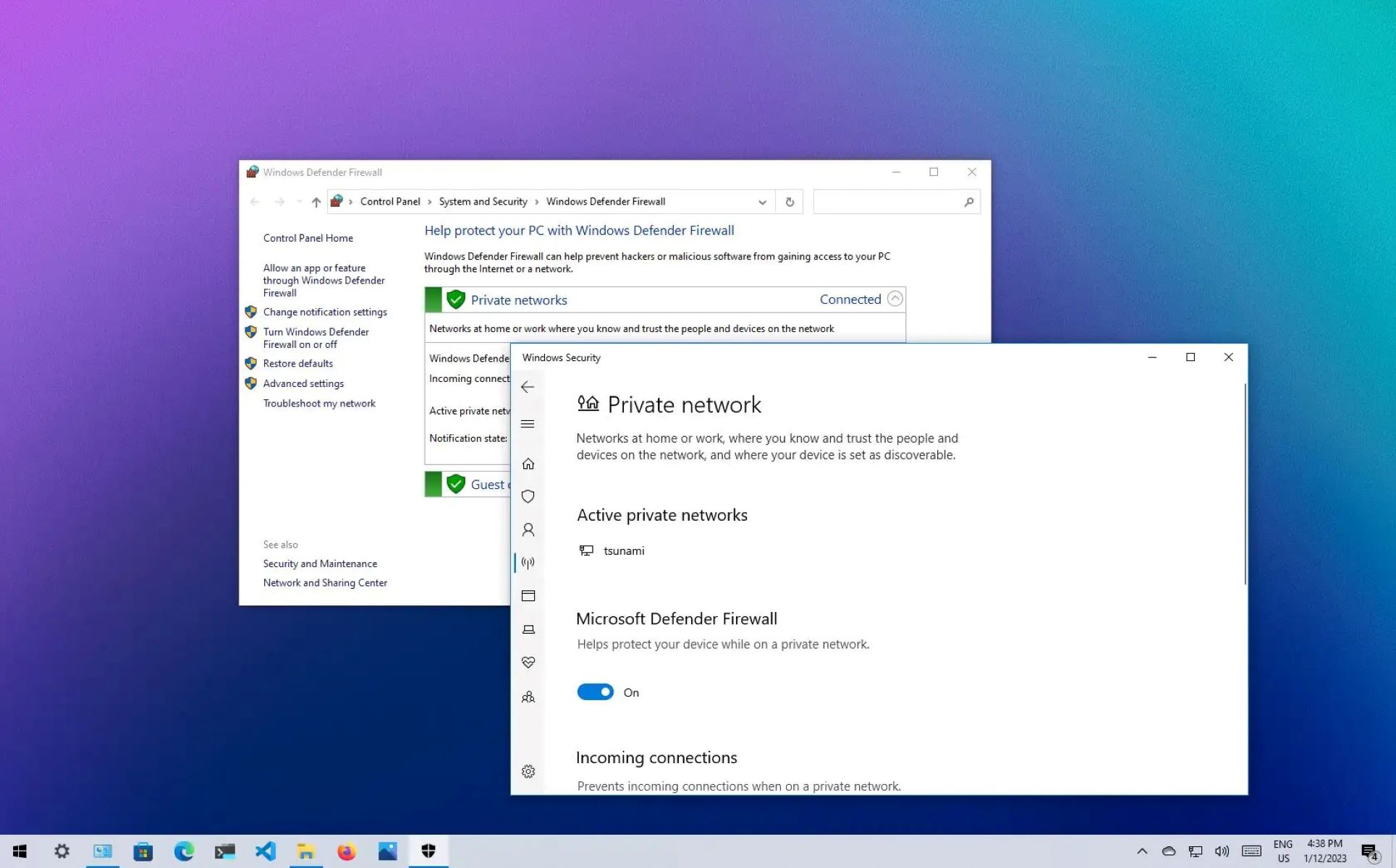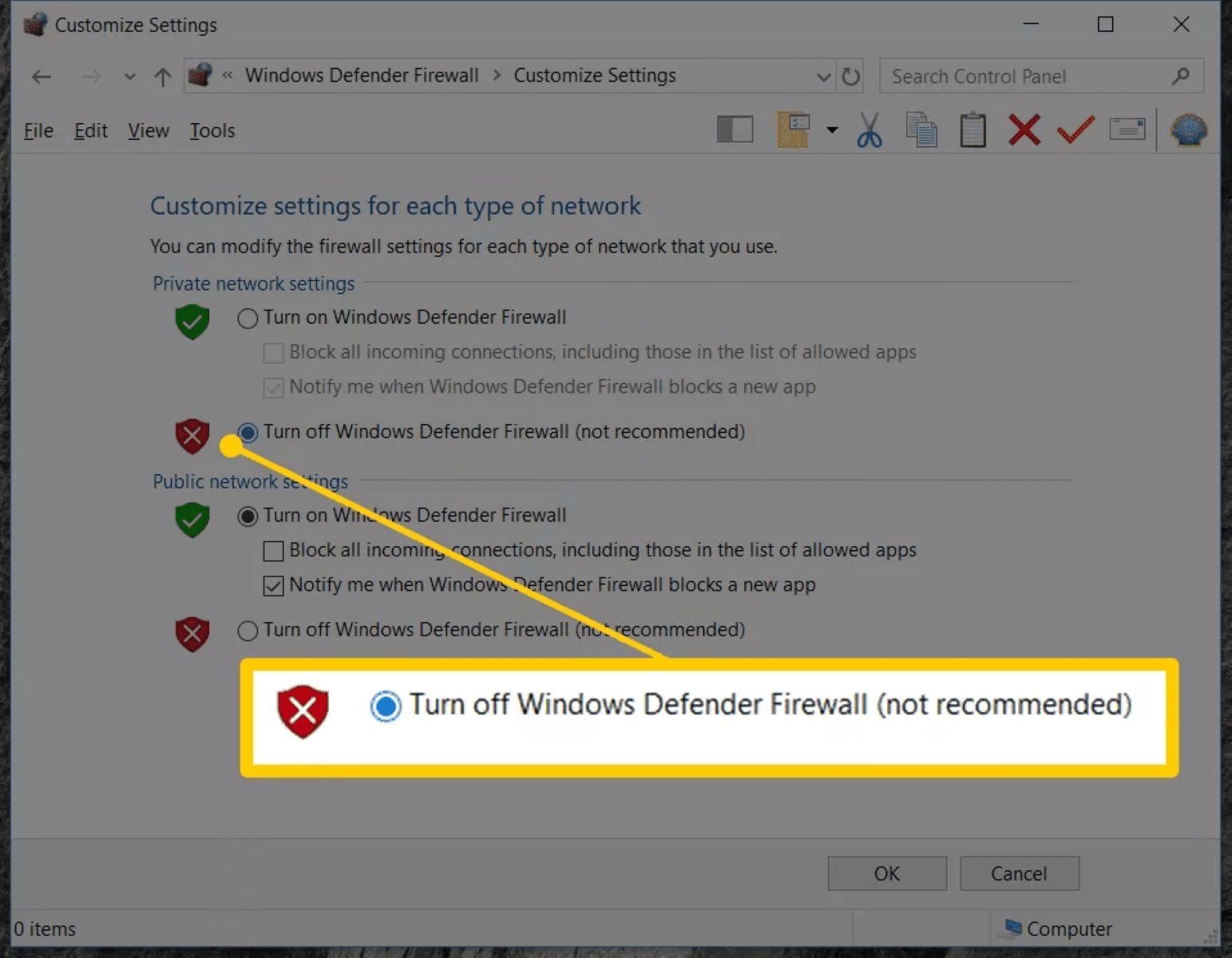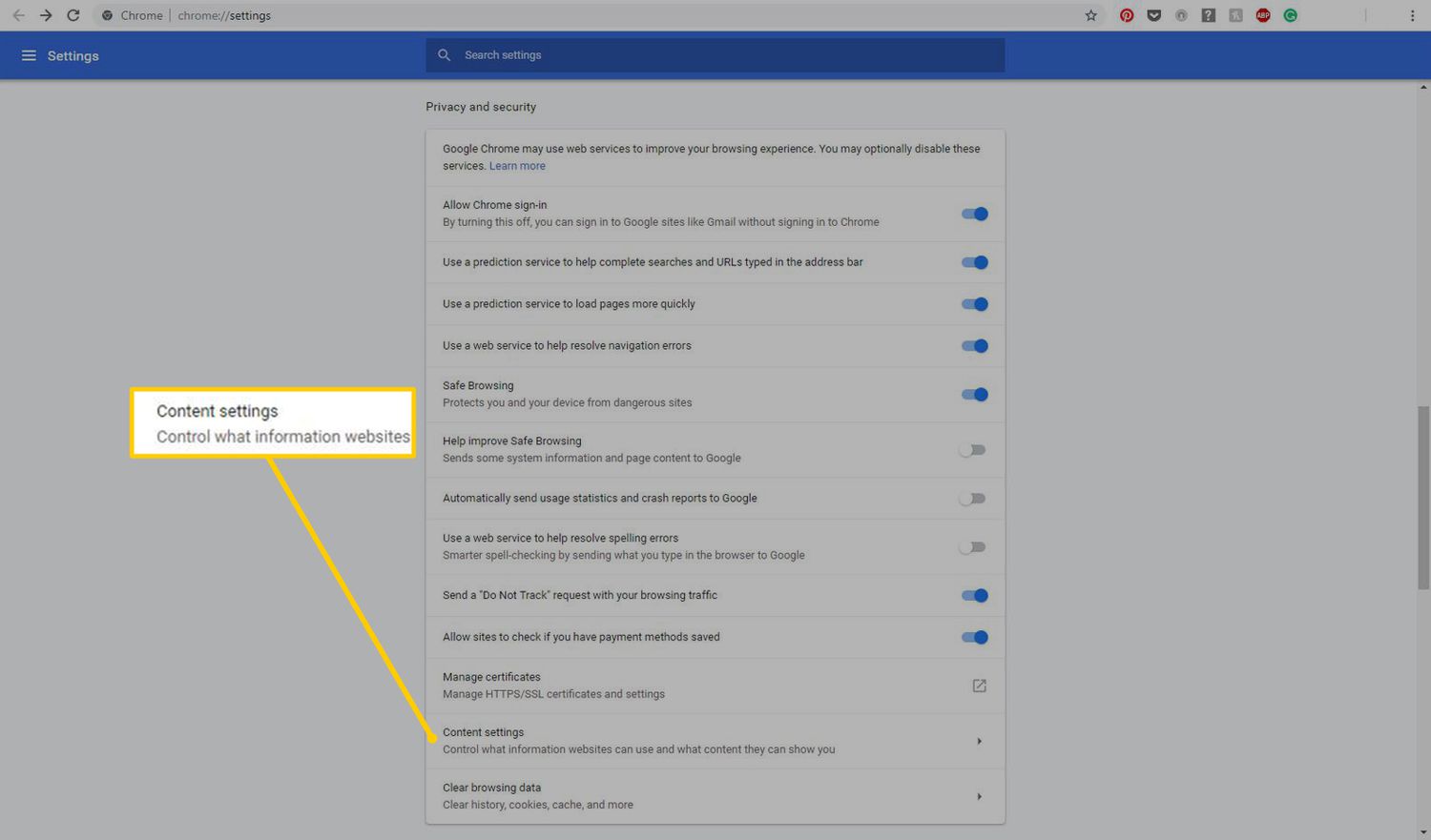Reasons to Turn Off Windows Firewall
Windows Firewall is a built-in security feature in Windows operating systems that helps protect your computer from unauthorized access and malicious threats. It acts as a barrier between your computer and the outside world, monitoring and controlling incoming and outgoing network traffic. However, there may be situations where you might need to turn off Windows Firewall temporarily or permanently. Here are a few reasons why you might consider turning off Windows Firewall:
- Conflicting Applications: In some cases, you might encounter conflicts between Windows Firewall and certain network applications, causing issues with connectivity or functionality. Disabling the firewall can help to troubleshoot and resolve such conflicts, allowing these applications to function properly.
- Third-Party Firewall: If you have installed a third-party firewall software on your computer that offers advanced features and better control over network traffic, you may want to disable Windows Firewall to avoid any conflicts or redundant security measures.
- Network Troubleshooting: When you face connectivity issues on your network, turning off Windows Firewall can help determine whether the firewall is blocking the connection or if there are other underlying network issues. If disabling the firewall resolves the problem, you can then re-enable it after troubleshooting the network.
- Compatibility: In rare cases, certain software or hardware devices may not work correctly with Windows Firewall due to compatibility issues. Disabling the firewall may be necessary to ensure seamless operation of these applications or devices.
- Advanced Network Configuration: If you are a network administrator or an advanced user who needs to configure specific network settings that are not possible with Windows Firewall, you may need to turn it off temporarily while performing advanced network configurations.
It is important to note that turning off Windows Firewall leaves your computer more vulnerable to potential security threats. Therefore, it is crucial to assess the risks and take appropriate measures to ensure that your computer remains protected. If you decide to turn off Windows Firewall, consider implementing alternative security measures such as using a reliable third-party firewall or ensuring that your computer’s security software is up to date.
How to Turn Off Windows Firewall in Windows 10
Windows 10 provides a straightforward way to disable Windows Firewall. Follow these steps to turn off Windows Firewall:
- Open the Start menu and click on the Settings icon (gear icon).
- In the Settings window, click on “Update & Security”.
- In the left panel of the “Update & Security” window, click on “Windows Security”.
- In the “Windows Security” window, click on “Firewall & network protection”.
- Under the “Firewall & network protection” section, you will see your network profiles (e.g., Domain network, Private network, Public network). Click on each profile one by one.
- In the profile settings, you will see the option “Windows Firewall”. Click on the toggle switch next to it to turn off the firewall for that specific network profile.
- Repeat step 6 for all the network profiles where you want to turn off the firewall.
That’s it! You have successfully turned off Windows Firewall in Windows 10 for the selected network profiles. Remember that disabling the firewall can leave your computer vulnerable to threats, so exercise caution and only turn off the firewall if necessary. Make sure to keep your computer protected with alternative security measures or by enabling the firewall when it is no longer needed.
How to Turn Off Windows Firewall in Windows 8/8.1
If you are using Windows 8 or 8.1, here is how you can turn off the Windows Firewall:
- Press the Windows key and type “Control Panel”. Click on the “Control Panel” desktop app that appears in the search results.
- In the Control Panel window, click on “System and Security”.
- Under “System and Security”, click on “Windows Firewall”.
- In the left panel of the Windows Firewall window, click on “Turn Windows Firewall on or off”.
- You will see the option to turn off the firewall for both the private and public network settings. You can choose to turn off the firewall for either one or both of these settings.
- Click on the checkboxes next to “Turn off Windows Firewall (not recommended)” for the network settings you want to disable the firewall on.
- Click “OK” to save the changes.
By following these steps, you will have successfully turned off Windows Firewall in Windows 8 or 8.1. However, keep in mind that disabling the firewall can expose your computer to potential security risks. It is recommended to only turn off the firewall temporarily when necessary, and to ensure that you have alternative security measures in place to protect your computer.
How to Turn Off Windows Firewall in Windows 7
If you are using Windows 7 and need to turn off Windows Firewall, follow these steps:
- Click on the “Start” button in the bottom left corner of your screen.
- Open the Control Panel by clicking on “Control Panel” in the right-hand column of the Start menu.
- In the Control Panel window, click on “System and Security”.
- Under “System and Security”, click on “Windows Firewall”.
- In the left panel of the Windows Firewall window, click on “Turn Windows Firewall on or off”.
- You will see two options for turning off the firewall: “Turn off Windows Firewall (not recommended)” for both private and public network settings. Select the appropriate option(s) based on your needs.
- Click “OK” to save the changes.
Following these steps will allow you to turn off Windows Firewall in Windows 7. However, it is important to note that disabling the firewall leaves your computer more vulnerable to security threats. Make sure to exercise caution and only turn off the firewall when absolutely necessary. It is recommended to have alternative security measures in place to protect your computer.
How to Temporarily Disable Windows Firewall
If you need to temporarily disable Windows Firewall on your computer, follow these steps:
- Open the Start menu and click on the “Settings” icon (gear icon).
- In the Settings window, click on “Update & Security”.
- In the left panel of the “Update & Security” window, click on “Windows Security”.
- In the “Windows Security” window, click on “Firewall & network protection”.
- In the “Firewall & network protection” window, click on the network profile (e.g., Domain network, Private network, Public network) for which you want to disable the firewall temporarily.
- In the profile settings, you will see the option “Windows Firewall”. Click on the toggle switch next to it to turn off the firewall for that specific network profile temporarily.
- The firewall for the selected network profile will be disabled temporarily until you manually turn it back on.
Remember that temporarily disabling Windows Firewall exposes your computer to potential security risks, so use this option only when necessary. Once you have resolved the issue or completed the task that required the firewall to be disabled temporarily, make sure to enable it again to protect your computer from unauthorized access and malicious threats. Alternatively, consider using advanced firewall settings or third-party firewall software for more granular control over network traffic while maintaining security.
How to Disable Windows Firewall in Group Policy Settings
If you are an IT administrator managing a group of computers on a network, you can disable Windows Firewall through Group Policy settings. Follow these steps:
- Open the Group Policy Management Editor by pressing the Windows key + R on your keyboard, then typing “gpedit.msc” and hitting Enter.
- In the Group Policy Management Editor window, navigate to “Computer Configuration” > “Administrative Templates” > “Network” > “Network Connections” > “Windows Firewall”.
- On the right-hand side, you will see various Windows Firewall policies.
- Double-click on the policy called “Prohibit use of Windows Firewall on your network”.
- In the policy settings window, select the “Enabled” option to disable Windows Firewall.
- Click “OK” to save the changes.
- Apply the Group Policy settings to the desired computer or group of computers by selecting the appropriate organizational unit (OU) or domain.
- Restart the computers or wait for the group policy to take effect.
By following these steps, you can disable Windows Firewall through group policy settings, effectively turning off the firewall for multiple computers on the network. However, it is important to consider the security implications of disabling the firewall, as it leaves the computers more vulnerable to threats. Ensure that you have alternative security measures in place and regularly monitor the network for any potential security breaches.
How to Disable Windows Firewall on a Specific Network Profile
If you want to disable Windows Firewall for a specific network profile on your computer, follow these steps:
- Open the Start menu and click on the “Settings” icon (gear icon).
- In the Settings window, click on “Network & Internet”.
- In the left panel, click on “Wi-Fi” or “Ethernet” depending on your network connection type.
- Under “Related settings”, click on “Change adapter options”.
- In the Network Connections window, you will see a list of network adapters. Right-click on the adapter that corresponds to the network profile you want to disable the firewall for, and select “Properties”.
- In the adapter properties window, scroll down and find the “Internet Protocol Version 4 (TCP/IPv4)” or “Internet Protocol Version 6 (TCP/IPv6)” entry.
- Click on the entry and then click on the “Properties” button.
- In the properties window, click on the “Advanced” button.
- In the “Advanced TCP/IP Settings” window, go to the “Options” tab.
- Under the “Windows Firewall” section, uncheck the box that says “Protect my computer and network by limiting or preventing access to this computer from the Internet”.
- Click “OK” to save the changes.
By following these steps, you can disable Windows Firewall for a specific network profile on your computer. Keep in mind that disabling the firewall leaves your computer more exposed to potential security threats, so exercise caution and consider implementing alternative security measures to protect your computer from unauthorized access and malicious activities.
Important Considerations Before Turning Off Windows Firewall
Before you decide to turn off Windows Firewall on your computer, it is crucial to consider the following factors:
- Security Risks: Windows Firewall plays a critical role in protecting your computer from unauthorized access and malicious threats. Disabling the firewall leaves your system vulnerable to potential attacks and compromises its security. Make sure to assess the risks and evaluate the necessity of disabling the firewall.
- Alternative Security Measures: If you choose to turn off Windows Firewall, it is essential to have alternative security measures in place. This can include installing a reliable third-party firewall, using comprehensive antivirus software, and regularly updating your operating system to ensure that your computer remains protected.
- Network Environment: Consider the type of network you are connected to. If you are connected to a public Wi-Fi network or an unfamiliar network with unknown security measures, it is generally recommended to keep the Windows Firewall enabled for added protection against potential network threats.
- Application Compatibility: Some network applications may not function correctly with Windows Firewall enabled. If you encounter compatibility issues or connectivity problems with specific applications, you might need to temporarily disable the firewall to troubleshoot the issue. However, remember to re-enable the firewall once the problem is resolved.
- Administrator Privileges: Disabling Windows Firewall typically requires administrative privileges. Ensure that you have the necessary permissions to modify firewall settings, as it may involve accessing system settings or configuring group policy options.
Ultimately, the decision to turn off Windows Firewall should be based on a careful assessment of the specific circumstances. It is recommended to leave the firewall enabled whenever possible to maintain a strong security posture. However, in situations where disabling the firewall becomes necessary, take adequate precautions to mitigate potential risks and employ alternate security measures to safeguard your computer.

























